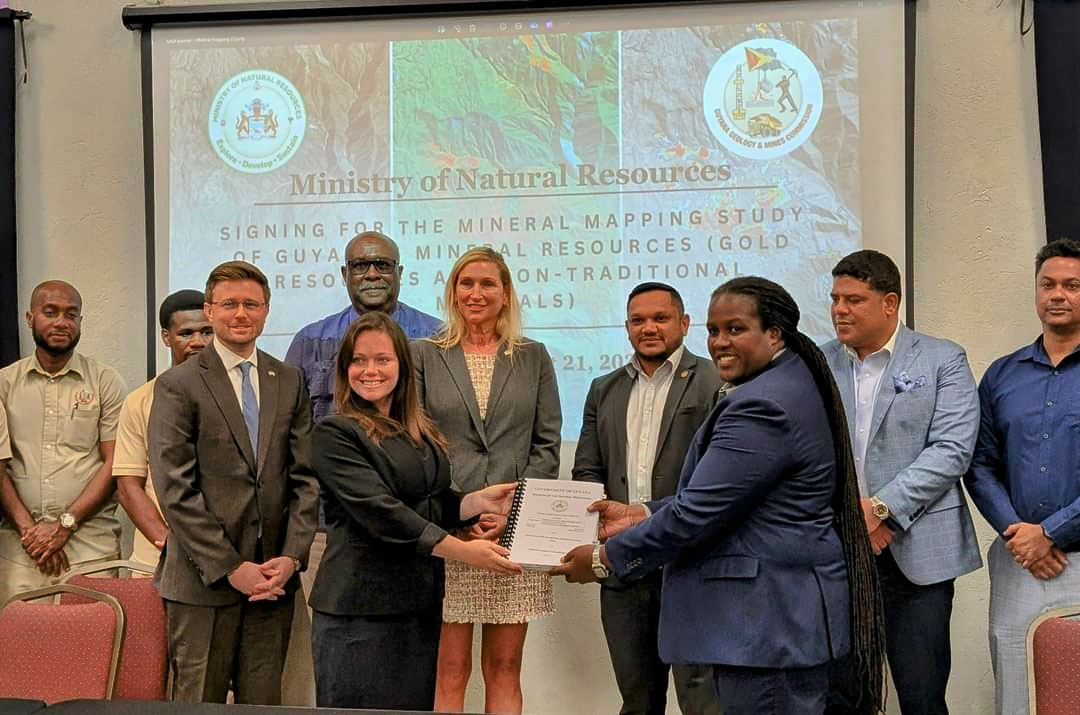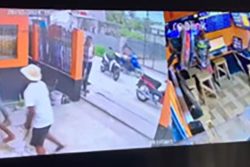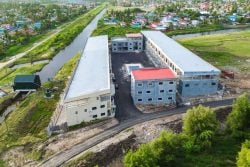Government and United States Company Global Venture yesterday inked a US$1.8 million (approximately $374 million) agreement for a one year, on-the-ground mineral mapping exercise here and announced that the company gave a 5% discount from its original US$1.9 million bid.
With $400 million budgeted this year for the project, Minister of Natural Resources Vickram Bharrat yesterday said that the one year duration where four key areas would be mapped was just one phase in the government’s overall plans for the mapping of this country’s mineral resources to obtain cutting edge target detection.
“This project is for one year and we focused on four main mining districts, being Mazaruni, Potaro, Northwest and Cuyuni. We did those and not Rupununi or Berbice for a number of reasons but mainly environmental sustainability as we don’t do too much mining in those areas… and most of the mining occurs in these four anyway,” he explained.
Bharrat explained that mineral mapping was a costly exercise and prioritizing areas for funding was also taken into consideration along with the type of mapping.
Aerial mapping, he informed, costs “way more” but it is hoped that at some time in the future Guyana would be able to pay to obtain this type of data. This newspaper understands that the average quote for the aerial mapping was pegged around US$40 million (approximately $8 billion).
One day after the mineral sold at the all-time record high of US$2531 per ounce, Bharrat said that while gold plays a significant part in the mapping exercise, “gold is not the only commodity that we are responsible for and are producing”. He announced that bauxite here was “turning around” and companies here were poised to increase their production. He also posited that lithium might be the most sought after mineral in the future. He has said that he believes, making clear he has no empirical data, that Guyana, a South American nation holds lithium deposits and the mapping exercise can highlight this. “We believe that there are traces of these critical minerals in Guyana…we are hoping that this project would highlight or point out to us that, yes Guyana does have minerals…,” he said.
Full potential
Chief Executive Officer of the woman founded and owned mineral mapping company Emily King said her company felt privileged to be selected for the project and recognize the importance of Guyana having the data coming out of it.
“Our team will work with GGMC [Guyana Geology and Mines Commission] and the MNR [Ministry of Natural Resources] to combine ‘tried and true’ methods to cutting edge innovation, to unlock the full potential of Guyana’s mineral resources…for the long-term benefit of all stakeholders”.
Outlining the work programme’s objective, she said they will provide a thorough review of all of the existing empirical data on mineral resources and geographical exploration in Guyana. This includes the consolidation and digitization of that information.
They will also hold stakeholder engagements as the company, “understand the success of this project hinges on collaboration” and they have designed a robust stakeholder programme to complement works to be done. These engagements, she said, will begin from “day one”.
A breakdown of phases and proposed costs is also planned so as to guide and help plan for continued mapping exercises.
A critical part of the project, King said, was the design and definition phase for airborne geophysics surveys paired with extensive ground sampling campaigns in the next phase. This planning will be carried out with the GGMC and MNR.
At yesterday’s signing, Guyana Gold and Diamond Miners Association President Gerald Alphonso said that small and medium-scale miners welcomed the initiative, as they “understand deeply the importance of responsible exploration and sustainable development.
“The study of our mineral resources, particularly gold and other non-traditional minerals, is vital not only for economic growth, but also for the advancement of our communities and the betterment of our people. We are grateful to the Ministry of Natural Resources for their commitment to this project and for recognizing the importance of inclusive dialogue with all stakeholders involved.
“This partnership will undoubtedly pave the way for more informed decision-making, enhanced collaboration, and responsible management of our natural resources,” he added.
Alphonso said that the small miners will seize this opportunity to demonstrate dedication to advancing the mining industry while preserving the environment and cultural heritage.
United States Ambassador Nicole Theriot said Washington was pleased that Guyana chose a US company to take it through this significant milestone, and underscored that mineral mapping here was more than just “a scientific exercise”. She underscored the potential having the data holds for Guyana, as it can assess its natural resources and can thus capitalize on them while simultaneously keeping its environmental sustainability initiatives intact. Theriot reasoned that the government can manage the mining of those natural resources to ensure it aligns with environmental priorities.
The US envoy said that the provision of crucial data “can guide policy making, attract investment and ensure that resource attraction is conducted in a responsible sustainable manner.
“One of the primary benefits of mineral mapping is that it provides a clear picture of what lies beneath the surface. Accurate maps identify new areas of exploration, the optimization of existing areas and of course, minimizing environmental impacts,” she said.
Bharrat last week announced that Global Venture Consulting had been selected from companies which had bid earlier this year for the contract. Global Venture’s US$1.9 million bid was the most responsive.
Watts, Griffis & McOuat Limited (WGM) of Canada had placed a bid of US$1.3 million along with an additional $88 million. Another Canadian firm, Technical Management Group Limited (TMG) in partnership with Purple Rock Inc submitted a bid of US$2.8 million while SLR Consulting Limited of the UK bid £156,976 (approximately US$204,590) but it did not include expenses. Oculus Geophysical Resources of the USA had placed a US$1.5 million bid.
Bharrat said that Guyana’s mineral inventory or mineral mapping had not been updated for decades and it was possibly due to the country not being able to afford it. However, he said that times have changed and coupled with the fact that this country can now afford it, mapping is also important for future planning.
“Today I think we are in a better position, and as a country too, with our commitment in the Low Carbon Development Strategy [LCDS] it is important and necessary that we start the mineral inventory process in Guyana this year,” he said.
China and Iran
In 2014, following the then Minister of Natural Resources Robert Persaud’s visit to China for the Mining Conference and Exposition, he had announced that the country would help with mineral mapping here.
The announcement was met with consternation and the following year the PPP lost the election and the project was not seen through.
Then a release said that during his presentation at the mining conference, Persaud stated that Guyana encourages green mining and investments that are environmentally safe and sustainable. He said this is guided by policies and programmes that are aimed at maximizing the benefits of the extractive sector. The release said that he cautioned that all investors must adhere to the various Acts and Regulations governing the mining sector and respect the laws of Guyana.
Persaud pointed out that numerous opportunities exist for investment in the mining sector, but investors have to comply with “strict environmental guidelines which are being enforced by several regulatory government agencies.”
In 2010, Iran had offered to assist Guyana with mineral mapping but the initiative appeared to have been snagged by the international sanctions that had been applied against Tehran over its nuclear energy programme.
Speaking about the project in June 2013, Foreign Affairs Minister Carolyn Rodrigues-Birkett had said that Iran’s mapping of the mineral resources had been shelved.
“The Iranians have promised that they will map our natural resources. It was a number of years ago but we didn’t move far with the whole issue because there are other countries that are also more experienced in this area… it has nothing to do … with this matter… we just didn’t move far with that,” Rodrigues-Birkett had told Stabroek News.






